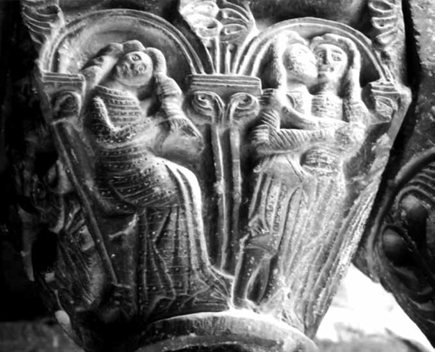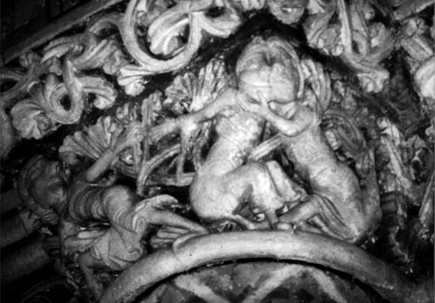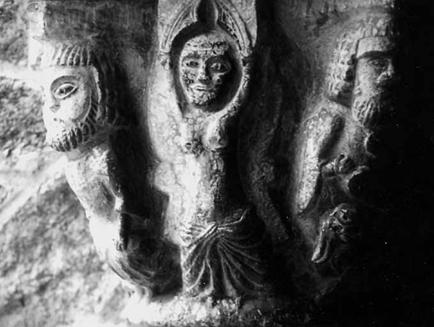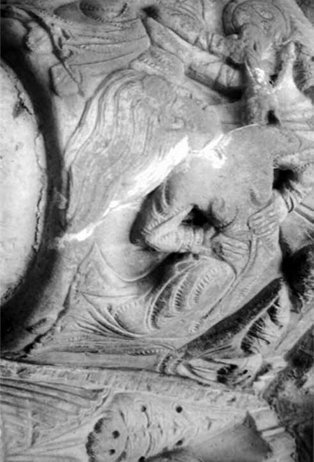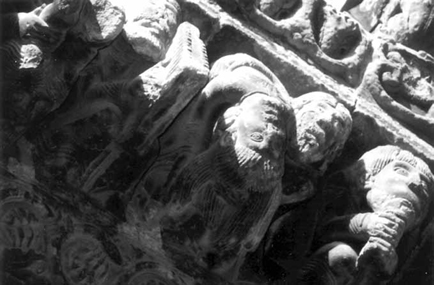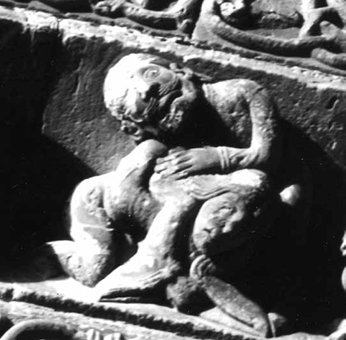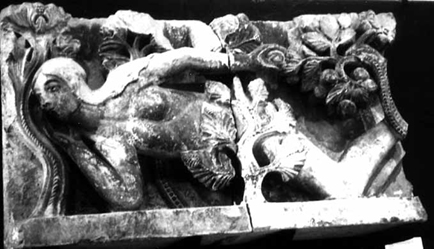Sex and the Romanesque in Occitania-Provence
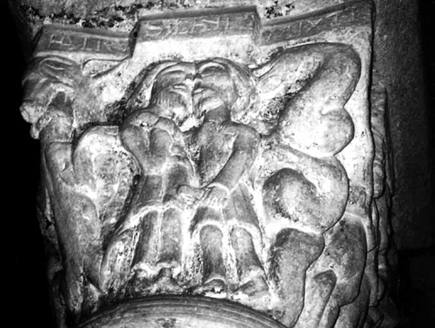
Chapter 17
Sex and the Romanesque in Occitania-Provence
Glenn W. Olsen
Some years ago I published an article on the erotic Romanesque sculpture of a single Cantabrian church, San Pedro de Cervatos.1 I doubt if there is any other church in Europe with such a profusion of sexual themes.2 Here I want to do something related but different, to assess the variety of sexual sculpture found on Romanesque ecclesiastical structures in one, albeit large, area of Europe from the late eleventh to the early thirteenth century. The goal in view is a first sketch of the possibility of a sexual topography, that is, an estimation of the incidence and variety of sexual themes found in one area over the period of about a century.3 The achievement of an exhaustive sexual topography is in significant ways impossible. Too much of the surviving sculpture is in an advanced state of decay, or has been partially destroyed. Too much of it is subject to honest disagreement in interpretation. Yet the idea of a definitive sexual topography, no matter how much out of reach, has a clarifying usefulness. At every step we may hesitate about the relations between this and that example, but the very attempt to set things in order reveals much. The aim of a first sketch is not comprehensiveness, but taking note of significant examples which illustrate a certain ordered variety.
With some license in observing geographical boundaries, the area to be studied is Occitania-Provence (though there is little of interest east of Arles) or simply the south of France, including those parts of Northern Spain, primarily Catalonia and upper Aragon but also the Christian lands westward to Galicia, which were intertwined with the history of southern France in the middle ages.4 This region, with its Spanish and Arabic connections, was already in the twelfth century associated with a literature celebrating, or at least exploring, human, sometimes adulterous, love.5 In modern scholarship it has been associated with the development of a moral code contrary to Christianity, in which love and pleasure stood to the front, but also with a conception of sublime love in which the erotic was enhanced by limitations set upon physical consummation.6
Surviving evidence does not usually answer all the questions we would ask of each sculpture, namely:7 who made it? (artist); when was it created? (date); who paid for it? (patronage); who looked at it? (intended audience); where did people look at it? (physical context); under what circumstances did people look at it? (use and purpose of object); what else does it look like? (iconographic models).
In spite of an increasingly sophisticated theoretical literature dealing with such questions as how men viewed women in the middle ages, the male gaze, and visual modesty, commonly we must be content with a contextual interpretation which falls short of a full answer to all the questions which could be posed.8
Eros, desire, and sex come in many forms, not perhaps exactly paralleling C.S. Lewis’ “four loves,” but in a range of articulation ranging from the most unreserved love of God to delicate expressions of friendship, courtship, flirting, and dalliance; through appreciation of the human body and its attractiveness, for instance in the act of dancing; through portrayal of intercourse; through exhibitionism, showing off the body, particularly its private parts, to shock or taunt; to unbridled pleasure-seeking, perhaps expressed in the acts of fellatio or masturbation.9 We find each of these in twelfth-century Occitania-Provence.10 It is often said that Christian suspicion of flesh and lust expresses an underlying hatred for or discounting of the body, and even all the denials of such an influential scholar as Caroline Bynum have far from completely dislodged such undifferentiated views.11 What we find in Romanesque sculpture is almost unending interest in the body and the shapes desire takes.
In denying that high medieval sublime love is a form of (Freudian) sublimation, C. Stephen Jaeger makes an observation of wide application: “Ennobling love makes no sense if the sexual is accommodated by sublimation, hence hidden.”12 The high medieval sense of the erotic was that it was something on display. The heroism of sublime love lay precisely in the fact that the struggle between lechery and love, the formidable enemy that love was to conquer, was visible to all. Such a perspective has obvious application to how we are to understand the relation between the frankness and the didacticism found throughout so much Romanesque art, which at once commonly “thrusts in one’s face” all kinds of sexual themes, but—if not simply engulfed in laughter—asks one to prevail against the temptations they represent. Psychomachia is the model here, a struggle going on in the soul— and on many medieval tympanums—between Virtue and Vice. “The erotic frankness typical of the discourse on ennobling love makes lust into a visible antagonist, not a hidden accomplice.”13 Jaeger’s analysis of literary texts sheds light on many other aspects of medieval culture. In Romanesque sculpture, as in Romanesque literature, there is a “double-optics” present in which one constantly passes back and forth from the frank presentation of sexual themes to a higher discourse of friendship, love, and the spirit. When didacticism is the goal, the point is not to eliminate the erotic, but to display the forces held in check by love, and admire the person who can do this. Even when the goal is not didactic—and I believe that less Romanesque sculpture is didactic than has been traditionally thought—the erotic is not less on display.
The medievals, especially following Gregory the Great, recast ancient interest in the gradus amoris into an exploration of the stages of lechery. Caught in medieval lists of the seven deadly sins, this effectively reshaped the gradus amoris into an anatomy of lechery, a study of descent into sin. Especially from the twelfth century, this could take the reverse form of a scala amoris tracing the progression of love from lower to higher. An ordered desire was one expressed within the bounds of nature, and a disordered desired aimed at passion for its own sake.14 Famously, St. Augustine had seized on the term “concupiscence” to name disordered desire, and by the end of the period of concern in the present chapter, a voluminous literature existed on all the illicit byways disordered desire might take. James Brundage has written an especially interesting article on the farther extreme here as found in canon law, studiosa concupiscentia, the deliberate lechery requiring a certain mental concentration and self-consciousness, to which perhaps the relatively well-educated clergy, whose stock-in-trade was supervision of the moral life, were themselves particularly prey.15 Such medieval frameworks and vocabulary for understanding sexual desire underlie the present contribution’s structure in a classification passing from ordered to disordered forms of desire.
In Christianity “God is love,” and when Christians speak of love they can intend a very wide range of meanings. Theologically love is ascesis.16 This is expressed most elementally in the idea that discipline undergirds spiritual growth.17 The idea is not specifically Christian. Plato’s survey in the Symposium of eros’ range was complemented in his Phaedrus by the image of the soul as a charioteer-driven team of two-winged horses, one noble, one ignoble. The noble draws us toward the eternal, the ignoble to the brutal. Thus eros may lead us upward or downward. Eros is central to our “ability to be pregnant,” that is to yearn for the eternal things which complete us, but always is in need of discipline and self-mastery. In the twelfth century as now, Christians could understand love as impossible without discipline; or in an opposed manner, as only possible with the relaxing of discipline. The first understanding is memorably caught by the former Jewish rabbi from Huesca, a convert to Christianity in 1106 and then a priest famous for his use of animal fables to teach Christian morality, Petrus Alfonsi (1062–c. 1110) in his Disciplina clericalis:18
I have found that the human spirit has been set down for this very purpose by the precept of the creator, that so long as it is in the world it may study and busy itself with holy philosophy, to have thereby a better and greater knowledge of its creator, to live in moderation and continency … and to follow that path in the world which will lead it to the kingdom of heaven … When a man has lived according to the aforementioned rules of holy “discipline,” he has indeed fulfilled that for which he was created ….
An understanding of the necessity of discipline still is the tension at the heart of Michel Foucault’s drawing of the ancient history of sex as a centuries-long attempt of discipline. After the coming of Christianity, it was the same: “love” could be understood theologically, as a form of self-giving and preference for the good of others, or as a form of gratification. Eventually specific projects could be proposed such as “‘Ad restringuendum coytum’: How to Cool Lust.”19 Here we will explore only the more earth-bound forms of love and sex, but historically they were but part of a larger centuries-long meditation on all the forms eros takes.
I would like to proceed from the more ordered to the less ordered forms of love as understood by Christian theology and canon law. We cannot always tell which form of love our sculpture intends to portray, whether, for instance, the subject of a sculpture is adulterous or marital love. But the norm of ordered love was that which led either through a progression from courtship through marriage and procreation, allowing perhaps for a certain amount of flirting along the way;20 or that which led from friendship to God, that expressed itself in spiritual forms of desire. A properly ordered desire could obey the laws of marriage and the lay state, or the laws of monastic friendship and desire for God. A disordered love might lead to improper dalliance or adultery, to forms of exhibitionism, to disordered pleasure-seeking acts such as sodomy or masturbation, or to league with the Devil.21
By the early middle ages, witness for instance the thought of Radbert of Corbie (Paschasius Radbertus, c. 790–c. 860), caritas most commonly was used to express the higher, unchanging and self-giving, forms of love, whether God’s divine love expressed in creation and redemption, or a proper human love, expressed in either friendship or marriage.22 Radbert even expressed the idea of ordered or ordinate love, ordinata caritas, a form of which structures the present chapter. The range of Radbertus’ usage persisted into the twelfth century, carried especially in the Church’s liturgical books, which commonly described marriage as caritas. Amor and dilectio also could be used to write of good forms of love and friendship, though both were thought less suitable because also having associations with corrupt forms of love. Especially amor could be equated with lust (cupiditas, etc.).23
Limitations of space demand that we pass over the ubiquitous and relatively better known portrayals of the more spiritual forms of desire—and therefore the highest forms of ordered love—and turn first to desire which leads to or is expressed in marriage. In talking about relations between the sexes, the categories of friendship, courting, and flirting are closely connected. Thus a capital at L’Estany in Catalonia dating from about 1124–1133, which shows an attractive young woman combing her hair as she awaits her suitor or lover (Figure 17.1).24 This may be a variation on a long-standing iconography in which a siren combs her hair, perhaps examining herself in a mirror. In any case, at L’Estany there is an appreciation of bodily beauty, though we are unclear about the nature of the love portrayed, licit or illicit. As evidence of a specifically licit love within marriage we find the fairly common theme of the “parting,” often placed with a castle or castle-door as background, of a lady and her knight.25 Such scenes remind us of the famous farewells of the Cid, who having declared to Doña Ximena “my noble wife, I love you as I love my soul!”, and having heard her prayer that, “though we now must part, … grant that we meet again in life,” receives a sort of authorial benediction “Ah, such sorrow was never seen! They parted as the nail is parted from the flesh.”26
Figure 17.1 Young woman combing her hair, capital at L’Estany, Catalonia
Source: Photo by the author.
If heterosexual love goes astray, one result may be libertinage, and another adultery.27 We seem to have the first in one of a series of mid-twelfth-century historiated capitals in the western apse of Saint-Jean de Besançon (FrancheComté), north of the area of primary concern here, devoted to the general theme of illicit desire. While a couple embraces, the woman’s parted dress revealing her leg, a man behind her strokes her hair. A neighboring capital apparently confirms that these are didactic figures, part of a series warning against improper desire, for here we see two small busts of a man and a woman, over each of which hovers a serpent.28 This is one variation on the luxury (luxuria = lechery) sculptures found all through the Romanesque world and considered below, in which the presence of a serpent warns of and expresses lechery.29 A capital at St-Pierre, Chauvigny (Figure 17.2), may also be of libertinage but more likely shows adultery.30 It has been restored in the most lively and effective way, though doubtless the use of paint by the restorer makes the subject of the capital clearer to us than it may have been in the middle ages. We seem to find on it the eternal triangle, a woman loved by one man but loving another. While a couple embraces on one corner of the capital, the woman extends an arm toward a man hidden in the foliage on another corner of the capital. That it is a woman continues the global idea that adultery is a woman’s crime, which no amount of Christian teaching had unseated.31 If the famous portrayal (1120–1135) on the tympanum of the west door of Sainte-Foy, Conques, of adultery among the sins receiving damnation leaves no doubt of adultery’s sinful nature, the sculpture at Chauvigny is more ambiguous.32 Here the adulteress’ body is not distorted by pain, but either rapt in a kiss, or admirably faking rapture.
Figure 17.2 Embracing couple and hidden lover, capital at St-Pierre, Chauvigny
Source: Photo by the author.
St. Ambrose (c. 340–397) had, not unreasonably, associated Salome and lewd dancing, but from the eleventh century the portrayal of the story of Salome dancing before Herod to obtain the head of John the Baptist was often an occasion to explore also the beauty, grace, and seductiveness of the female figure.33 We might call this an ordered but ambiguous form of eros, carrying possibilities for temptation. A famous example (c. 1120–1140) on a capital from Saint Étienne, Toulouse, now in the Musée des Augustins of that city, shows a seated but dominating Herod caressing a diminutive Salome on the chin, caught at either the beginning or end of her dance.34 Many other representations will show her in the middle of her dance, and the orientalized, form-fitting dress of this sculpture was widely copied. An earlier rather primitive cloister capital of disputed subject-matter at Saint-Martin-du-Canigou, relatively close to Toulouse, was however quite distinct.35 Here in the oldest Catalan example of the First Romanesque we have either a narration of the story of John the Baptist, or a capital of mixed subject matter. On one side of the capital we find either the beginning of the story, or simply a dancer and musicians. Then we have either Salome dancing, or a luxuria figure (Figure 17.3).36 In either case, the sculpture is unusual. Luxury figures, typifying the sin of lechery or carnal wantonness, are usually unclothed and have serpents, toads, etc., attacking their breasts and pubic area, but this figure is clothed from the waist down, and especially the placement of her hands indicates she is dancing. Salome figures, by contrast, as at Toulouse, in the twelfth-century usually are completely clothed, though in clothing which is tightly waisted and revealing of rounded breasts.37 To be sure, there is a luxuria figure nude from the waist up in Bibl. Nat. Lat. 2077, a manuscript on virtues and vices from Moissac written about 1100, which figure is seated cross-legged like the famous so-called “Adulterous Woman” of the south porch at Compostela and looks like a more refined form of our sculpture at Saint-Martin, but it is not of a dancer.38 On balance, it seems more likely that the primitive, rather stern, figure at Canigou is a Salome.
Figure 17.3 Salome dancing, or a luxuria figure, capital at Saint-Martin-duCanigou, near Toulouse
Source: Photo by the author.
From the twelfth century many examples survive on both sides of the Pyrenees of a sensuous Salome, hair swinging and body almost bent over in dance. The military orders were especially prominent in southern France in the twelfth century, and we find a fine example of a Salome on a choir capital at La commanderie d’Aubertin, in the Atlantic Pyrenees.39 The commonness of representations of Salome seems to have escaped some art historians, who identify various figures simply as dancers, not recognizing the iconography of the Salomes.40 Most of the figures of concern here are in upper Aragon. To select but one of several similar examples, at the end of the century we find the most pleasing expression of the type, on the small, isolated church of Santiago outside Agüero, northwest of Huesca.41 Here, stretched over two capitals, we have perhaps the beginning of the dance. In any case Salome stands between musicians on either side.42 Then we have the dance at full tilt (Figure 17.4).
There are many other dancing figures on churches and in manuscript illuminations. In their tight-fitting dresses some seem already representations of the incitement to lechery through clothing against which in the mid-thirteenth century Vincent of Beauvais in his tract on the formation of royal children was to warn.43 It is difficult to come to a fair judgment of such materials. Clearly many of them find new joy in bodily beauty, but often the old association of dance with temptation and the demonic seems not far away.44 The dancing figures often are related to carnivalesque, joculator and minstrel themes of the order I treated in my study of Cervatos; or to the imitation of the antique we find in the nude or thinly veiled bodies at places like San Isidoro, León, and Jaca cathedral, the latter with its wonderful capital of figures playing in the waves, a double-flute player on each side of an almost nude dancing couple.45
Figure 17.4 Salome dancing, capital at church of Santiago outside Agüero
Source: Photo by the author.
Figure 17.5 Man bending a woman over while dancing, south porch at Santa Maria de Uncastillo,
Source: Photo by the author.
Musicians could be associated with a disordered life, but also with the enjoyment of life.46 One of the most amusing and sophisticated ensembles is found on the south porch at Santa Maria de Uncastillo, again in Aragon. At least two of the sculptures on this church seem to be of dancing. Far up the exterior southeast apse wall we have a relatively difficult to see sculpture of a couple dancing, placed next to a musician. Then, on the south porch we have a couple of which the man may be helping a woman gymnast (Figure 17.5— contortionism often symbolizes the sins of a disordered and depraved life).47 More likely, because the couple has musicians on both sides, the sculpture is of a man bending a woman over while dancing. It is not easy to take in this crowded scene. Five figures to the right of our bent-over figure we have another figure whose interpretation is disputed. Some have said that it is a picture of spanking, but if so the man has a rather bad aim (Figure 17.6).48 It seems more likely that we have here some form of sex-play or caressing. The man’s animated face is difficult to read, but the woman’s expression seems tranquil, not what we would expect if spanking was the subject. Further, the man seems with one hand to be smoothing the long tresses of the woman whose head lies on his lap, and his other hand apparently is on her breast. The scene of general merriment slides into ribaldry when we examine the group of animals and people at the table below our dancers. At its head is a jackass, whose genitals are on exhibition below the table.49 Many forms of exhibitionism including exposure of one’s vulva or penis, solitary or mutual masturbation, display of coition in various positions, self-fellatio, and possibly self-asphyxiation are found in the south and west of France and the north of Spain, some of them clearly intended to shock or warn, some, like this, to amuse.50
Figure 17.6 Man and woman, possibly at sex-play, south porch at Santa Maria de Uncastillo, Aragon
Source: Photo by the author.
Only by an expansive definition of the south of France can we introduce a kind of companion piece to the dancing Salomes, namely the famous Eve of Autun (Figure 17.7), apparently sculpted about 1130 on the lintel of the lateral portal of Saint-Lazare at Autun, and now in the Musée Rolin of that city.51 Linda Seidel has revolutionized our understanding of the cathedral of Autun, and we apparently are no longer to attribute this work to Gislebertus, who turns out to be not a famous twelfth-century sculptor but the Carolingian founder, Giselbert, of a pilgrimage church for housing the relics of St. Lazarus.52 The Eve, with its very original vision of the first sin, is our best evidence of growing Romanesque interest in the body, sensuously portrayed, and in nudity.53 It is probably too much to ask that the mysterious Honorius Augustodunensis (c. 1080–c. 1156) actually be from Autun, and thus be doing a gloss on currents there in his day, but in one of those speculations on how the blessed will look which Caroline Bynum has dissected, Honorius holds, in Bynum’s words, “the blessed will rise naked and unembarrassed.”54 In an age in which nakedness was still most commonly associated with punishment and damnation, at least this articulates one theologian’s conceiving the possibility of an unembarrassed nudity.
Figure 17.7 Eve of Autun, lateral portal of Saint-Lazare, Autun
Source: Photo by the author.
Some now speak of “Romanesque Humanism,” which they associate with such work around 1100 as the sculptures of Bernard Guildin in Saint-Sernin, Toulouse. According to this view Guildin’s Christ in Majesty has “a new aesthetic … a personal interpretation of the legacy of classical antiquity … greater suppleness of drapery, a more tangible plasticity, and an astonishing facial expressivity.”55 At Moissac the humanity of the Incarnate Christ is emphasized, and at both Moissac and Toulouse a certain sensuality is expressed in ornamental decoration, found also in the vegetation of the Eve of Autun.56 In both France and Spain, alongside a fascination with such natural processes as childbirth and such scatological themes as relieving oneself or baring one’s anus, we find many charming pieces exploring the attractiveness of the human body.57 There is nothing quite like the Eve of Autun anywhere else. Her long hair stands out and, dreamy-faced, she moves through the Garden of Eden as if she were herself a serpent. Her breasts are not the dugs of most twelfth-century female nudes, but gently full and finely modeled, and her nudity is heightened by the way in which her upper body twists towards the viewer.58 The motion of her body is replicated by the sensuous plants with which she is surrounded. She may be whispering to a now-lost recumbent Adam. For comparison one would have to go to the pensive, full-breasted Eve on the cathedral portal at Lodi in Lombardy from the last quarter of the century.59
The Eve of Autun might be viewed in conjunction with the sculpture of the west portal of St. Trophime in Arles, constructed about 1180 or 1190, one of the few churches of Provence as geographically defined today which is at least in part an exception to the generalization that, in comparison to the churches of Burgundy, the Romanesque churches of Provence are modest and sober. Some judge it the finest Romanesque church in Provence. The increasing preoccupation with the beauty and sensuousness of nature evident in the Eve of Autun is also found in the “Roman revival” architecture at St. Trophime.60 The Eve and Adam at Arles cannot match the Eve of Autun, but we find a similarly sensuous foliage under the portrayal of Adam and Eve (1150–1185) and above St. Michael the weigher of souls, on the left side of this porch. Under St. Michael we also have the famous flying Hercules, whom one thinks might rival the Eve of Autun, which it recalls, if only it had been better preserved.61 This expresses an interest in the nude male body similar to that found in various other sculptures imitating classical works, such as the scene of Orestes’ slaying of Clytemnestra from Sophocles’ Orestia
